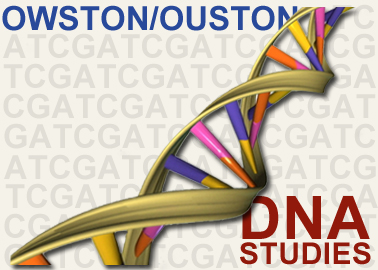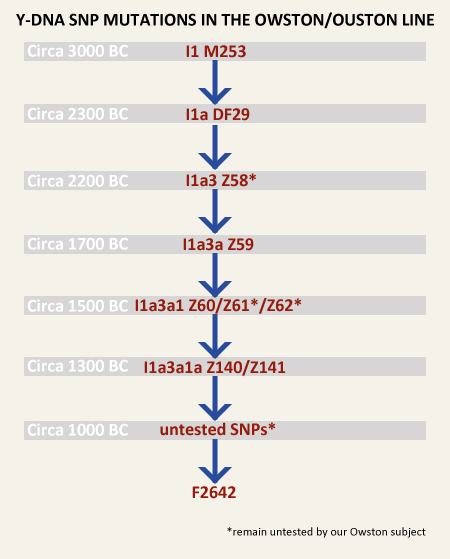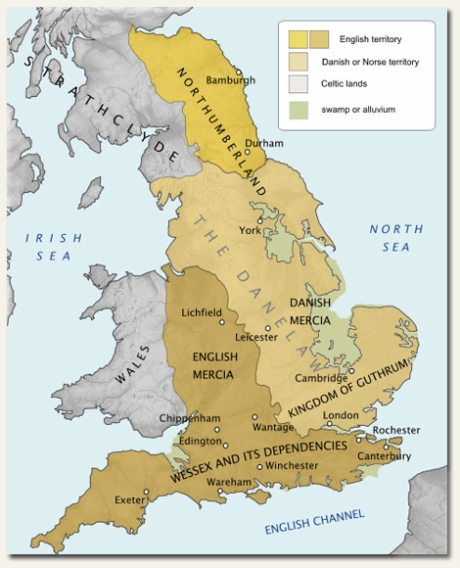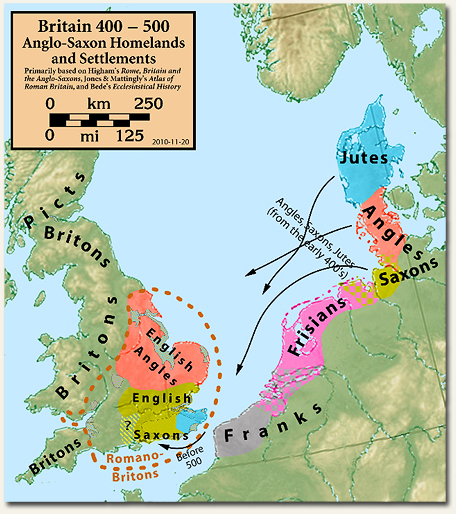
This week, it was reported that another individual in the National Geographic Genographic 2.0 project has tested positive for the F2642 Y-DNA mutation. This is the second known participant in the I1 communities who has tested positive for F2642. It is interesting to note that his genealogical origins are in France. This certainly allows for the possibility that Owston forebears were Norman; however, until others test and produce the same results, it is impossible to know at the present where our ancestors originated.

As stated previously, it appears that center of development of I1 Y-DNA occurred 5,000 years in the past in the region that encompasses what is currently Northern Germany and Southern Denmark. Individuals with the I1 haplogroup apparently moved in all directions from there.
Previously, it had been thought that the Owstons were of Viking stock; however, this was based on circumstantial evidence at best. According to Mower (1924) and Smith (1962), the “Ows/Ous” prefix in Owston/Ouston is from the Old Norse word austr meaning “east” and “ton” is from the Old English “tun” for farmstead or dwelling. Because of the etymology the name and the geography of our origins within the Danelaw, it was possible to speculate that our earlier patrilineal ancestors may have been Danish Vikings.
While the assumption appears to be logical, Owston and its variant Ouston are locative names and may have less to do with ancestry than they do with where the family originated. Without any further data, however, it is equally possible that our patrilineal ancestors were Norman or for that matter Angles who had invaded England much earlier, but also settled in the East Riding of Yorkshire.
In addition to Danes and Norwegians, a high percentage of Germans share the M253 mutation that define the I1 haplogroup. Redmonds, King, and Hey (2011) caution, “. . . a problem arises, when we try to identify Anglo-Saxon, Danish Viking, and Norman ancestry, because these historical groups were separated by just a few generations in the same part of Europe. It is frequently not possible to say definitely where a man’s Y-chromosomal cultural ancestry originates” (p. 199).
Even if we fine tune our speculation with STRs (Short Tandem Repeats), we are no better off in determining the ultimate origins of our ancestors. A comparison of the STRs (Short Tandem Repeats) of the Owston participant in Geno 2.0 and the other F2642 individual shows an 11 marker difference at 67 markers. This indicates that, even though they share the same SNP mutation, they are not closely related.
Currently, the I1 project at Family Tree DNA has 91 participants that have consistent STR mutations that place them into a subclade called the 14/22 Greater Complex – the same subclade that most Owstons and Oustons fall. It is also the same subclade in which the other F2642 Geno 2.0 participant is a member.
Of the 91 individuals in the 14/22 complex, the origins of the majority of these families are reported as being from the British Isles with the largest constituency being from England – including the Owstons/Oustons. The numbers are as follows:
- British Isles – 45 or 49.4%
- England – 28 or 30.7%
- United Kingdom (unspecified) – 6 or 6.5%
- Scotland – 6 or 6.5%
- Ireland – 5 or 5.5%
- Germany – 11 or 12.1%
- Denmark – 4 or 4.4%
- France – 4 or 4.4%
- Netherlands – 2 or 2.2%
- Czech Republic – 1 or 1.1%
- Poland – 1 or 1.1%
- Switzerland – 1 or 1.1%
- Ukraine – 1 or 1.1%
- United States – 1 or 1.1%
- Unknown – 20 or 22.0%
While it is exciting that another individual tested positive for the F2642 mutation, it puts us no closer in knowing our specific origins beyond the 15th and 16th centuries. One thing that appears to be certain, we have invader DNA. Unfortunately, we do not at present know which invaders contributed our Y-DNA and it is likely we may never know for sure.
REFERENCES
Distribution of European Y-chromosome DNA (Y-DNA) haplogroups by country (2010). Europedia.com. http://www.eupedia.com/europe/european_y-dna_haplogroups.shtmlyDNA haplogroup I: Subclade I1 results. (2013). Family Tree DNA. http://www.familytreedna.com/public/yDNA_I1/default.aspx?section=yresults
Mower, A. (1924). The chief elements used in English place names. Cambridge: The University Press.
Nordtvedt, K. (2012). I1xL22xZ58 tree. http://knordtvedt.home.bresnan.net/Tree%20for%20I1xL22xZ58.pdf
Nordtvedt, K. (2013). I1 Z58+ tree. http://knordtvedt.home.bresnan.net/Tree%20for%20I1%20Z58+.pdf
Nordtvedt, K. (2013). The I1 modalities. http://knordtvedt.home.bresnan.net/The%20I1modalities.xls
Owston, J.M. (2012). His name is my name too: A Y-DNA study of the Owston surname and its variants. http://www.owston.com/dna/Owston_Family_Y-DNA_Study.pdf
Owston, J.M. (2012). Owston DNA studies: A new Y-DNA mutation found in the Owston/Ouston family. Owston/Ouston One Name Study. http://owston.wordpress.com/2012/12/22/owston-dna-studies-a-new-y-dna-mutation-found-in-the-owstonouston-family/
Redmonds, G., King, T., & Hey, D. (2011). Surnames, DNA, and family history. Oxford, England: Oxford University Press.
Smith, A. H. (1962). The place names of the West Riding of Yorkshire. Cambridge: The University Press.
Y-DNA haplo I1 Z140+ [incl. downstream SNPs L338 and L592 [private]]. (2013). Facebook. https://www.facebook.com/groups/352630428131255/
http://owston.wordpress.com/2013/01/08/owston-dna-studies-another-f2642-y-dna-mutation-reported/


Комментариев нет:
Отправить комментарий